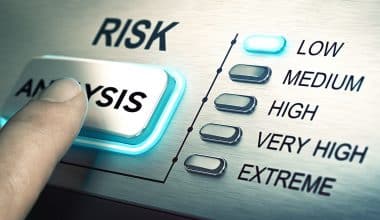It is crucial to make sure that cybersecurity risk management endures over time. There is a need for continual cybersecurity risk management as the company and the external threat landscape evolve after an initial vulnerability risk assessment has identified all of the organization’s digital assets and examined existing security measures. So this article covers all you need to know about cybersecurity risk management.
What is Cybersecurity Risk Management?
Cybersecurity risk management is the constant process of finding, assessing, evaluating, and responding to cybersecurity threats in your organization.
Cybersecurity risk management is the responsibility of everyone in the organization, not just the security personnel. Employees and business unit leaders frequently regard risk management as a separate business activity. Regrettably, they lack the complete and consistent viewpoint required to confront risk.
Each function has its own goal, frequently accompanied by a lack of understanding and empathy for others. IT pioneers new ideas and technology, continually perceiving security and compliance as inconvenient hurdles to growth. Security is aware of safety but often out of touch with legislation and evolving technologies. The sales staff wants to keep its customers pleased, and they are seeking for a practical solution to execute security checks. Compliance tries to keep everyone out of trouble by strictly adhering to regulations, yet it frequently operates without a thorough understanding of security.
All functions must operate with clearly defined roles and responsibilities to effectively manage cybersecurity risk. The days of isolated departments fumbling along in disjointed bewilderment are long gone. Today’s risk landscape necessitates a cohesive, coordinated, disciplined, and consistent risk management approach. The following are some critical risk management action components that all firms must remember:
- Creating strong policies and tools to assess vendor risk
- Identifying emerging risks, such as new rules with business implications
- Internal flaws, such as a lack of two-factor authentication, are identified.
- IT risk mitigation, possibly through training programs, new regulations, and internal controls
- Overall security posture testing
- Documentation of vendor risk management and security in preparation for regulatory audits or to reassure new customers
What are the Benefits of Managing Cybersecurity Risk?
A business can prevent its daily operations from treating cybersecurity as an afterthought by implementing cybersecurity risk management. A plan for managing cybersecurity risks in place guarantees that protocols and policies are followed regularly and that security is kept up to date.
The following dangers are continuously monitored, identified, and mitigated via cybersecurity risk management:
- Phishing detection,
- VIP and executive protection,
- Brand protection,
- Fraud prevention,
- Monitoring of sensitive data leakage,
- Activity on the dark web,
- Automated threat mitigation,
- Monitoring of leaked credentials,
- Identification of malicious mobile apps,
- and supply chain risks are just a few examples.
Cybersecurity Risk Management Framework
For security leaders across nations and businesses, a cybersecurity framework offers a common language and set of standards that allow them to comprehend their security postures and those of their providers. A framework makes it much simpler to specify your organization’s steps to evaluate, manage, and reduce cybersecurity risk.
A cybersecurity framework can serve as an important benchmark.
The foundation for incorporating cyber security risk management into your security performance management and third-party risk management strategies is provided by cybersecurity frameworks, which are often required. You’ll gain crucial insight into your greatest security risk by using a framework as your compass, and you’ll feel comfortable telling the rest of the organization that you’re dedicated to security excellence.
NIST Framework for Cybersecurity
The former president’s executive order, Improving Critical Infrastructure Cybersecurity, called for increased cooperation between the public and private sectors for identifying, assessing, and managing cyber risk. In response, the NIST Cybersecurity Framework was created. NIST has emerged as the gold standard for evaluating cybersecurity maturity, identifying security gaps, and adhering to cybersecurity regulations, even though compliance is optional.
Norms ISO 27002 and 27001
The ISO 27001 and ISO 27002 certifications, created by the International Organization for Standardization (ISO), are regarded as the global benchmark for verifying a cybersecurity program internally and with external parties. With an ISO certification, companies can demonstrate to the board, customers, partners, and shareholders that they are doing the right things to manage cyber risk. Likewise, if a vendor is ISO 27001/2 certified, it’s a good indicator (although not the only one) that they have mature cybersecurity practices and controls.
NERC-CIP
Introduced to mitigate the rise in attacks on U.S. critical infrastructure and growing third-party risk, the North American Electric Reliability Corporation – Critical Infrastructure Protection (NERC CIP) is a set of cybersecurity standards designed to help those in the utility and power sectors reduce cyber risk and ensure the reliability of bulk electric systems.
The framework requires impacted organizations to identify and mitigate cyber risks in their supply chains. Several controls are outlined in NERC-SIP, such as classifying systems and critical assets, training staff, incident response and planning, recovery plans for critical cyber assets, vulnerability assessments, and more. Learn more about NERC-CIP compliance strategies that work.
Cybersecurity Risk Management Salary
The average annual salary for a Cyber Risk Management in the United States is $102,856 per year as of December 19, 2022.
Suppose you need a quick salary calculator that costs around $49.45 per hour. This equates to $1,978 each week or $8,571 per month.
While ZipRecruiter has yearly earnings as high as $167,000 and as low as $29,500, the bulk of Cyber Risk Management salaries in the United States now range from $74,500 (25th percentile) to $126,500 (75th percentile), with top earners (90th percentile) making $156,000. The average salary range for Cyber Risk Management varies substantially (up to $52,000), implying that there may be numerous prospects for promotion and higher income depending on skill level, location, and years of experience.
According to recent ZipRecruiter job posts, the Cyber Risk Management job market in Atlanta, GA, and the surrounding area is active. A Cyber Risk Management in your area earns an average yearly salary of $101,973, which is $883 (1%) less than the national average annual pay of $102,856. Georgia ranks 49th out of 50 states regarding Cyber Risk Management salary.
ZipRecruiter regularly checks its database of millions of active jobs advertised locally across America to generate the most accurate annual salary range for Cyber Risk Management positions.
This position is crucial in preventing security catastrophes by spotting any potential weak spots in your information systems. These experts evaluate the security measures in place and prevent potential attacks on your business’s computers, networks, and data.
Salary of a Cyber Security Engineer
With average cybersecurity salaries ranging from $120,000 to $210,000, the position of cybersecurity engineer also brings in one of the highest salaries in the security sector.
Companies hire these experts for their skill sets and experience because they are primarily responsible for various security engineer tasks, such as designing, developing, and implementing secure network solutions to protect against sophisticated cyberattacks, hacking attempts, and persistent threats.
Salary of an Application Security Engineer
Application security engineers are the third-highest-paid cybersecurity professionals, with annual salaries ranging from $130,000 to $200,000.
Employing an application security engineer is essential if your business uses software solutions offered or hosted by third parties, such as AWS or Microsoft’s Azure, or even if you develop your solutions from scratch.
These experts will safeguard all business applications and software used by your workforce and ensure that all privacy and compliance requirements are incorporated into the software and adhered to.
Salary of a cyber security analyst
The average salary for this position in cybersecurity ranges from $95,000 to $160,000, and it is well worth it.
These security experts assist in developing, organizing, and implementing security measures to safeguard your infrastructure.
They are specially equipped to identify vulnerabilities before hackers have a chance. They have the knowledge and experience to collaborate with penetration testers and information security managers to mitigate and avoid cyberattacks that could severely damage your business.
When Should Information Security Managers be Hired?
Were you looking to safeguard customer data and stay clear of the costs & penalties associated with having your private information compromised or stolen? Do yourself a favor and fill this position before your business suffers. You are forced to budget for expensive fines for failing to protect customer data, like Uber, which was penalized $148 million for breaking state laws requiring data breach notification.
Cybersecurity Risk Management Plan
Depending on your organizational requirements and objectives, choose the best approach, which can be quantitative, qualitative, or a combination of both.
A quantitative approach gives you insight into the financial impact a particular risk brings, while a quantitative approach gives you visibility into the organizational impact in terms of productivity.
As per NIST Special Publication 800-30, a risk assessment can be carried out at the tactical or strategic level.
Making an inventory of all assets and organizing them according to priority, importance, and the type of information being assessed is the first and most important step in the security risk assessment process.
Obtain support from all interested parties and decide how to categorize the informational assets.
#1. Sort Cybersecurity Risks by Priority
Determine what data is accessible, to whom, and how it can be breached.
With the IT landscape widening and organizations adopting newer technologies and different modes of conducting business, such as shared infrastructure or third-party services running atop an existing software stack, data loopholes can exist in the most unexpected territories.
In addition to the transforming landscape, many compliance policies and regulatory practices reinforce the importance of identifying every possible security incident or data breach that can surface in the infrastructure web.
Once you’ve identified and classified the informational assets, identify the potential threat channels.
As we maneuver along the dynamic threat landscape, it’s important that we keep ourselves up-to-date on the triggers and controls and evolve to devise different strategies to counter these threats with the changing needs.
Data security incidents range from external attacks, malicious users and software, vulnerabilities introduced as a result of negligence, natural disasters, and insider threats.
Security lapses result in lost revenue, reputational harm, legal repercussions, disruption of business continuity, and a long list of other negative effects.
Through scanning, penetration testing, and auditing controls, find network vulnerabilities.
Vulnerabilities live on the network or in the application and are weak spots that go unnoticed because of oversight and a lack of agility to take note of system flaws.
With more and more companies hosting and running their applications on the cloud, the chances of introducing such weak spots are high.
The threats that target such vulnerabilities are external, internal, structured, and unstructured.
#2. Determine Risk Prevention and Mitigation Strategies for Cybersecurity
It’s time to develop mechanisms to avoid the threats you’re likely to face after evaluating the information assets and identifying potential security threats connected to those assets.
Deploy Security Monitoring Tools
Deploy all necessary infrastructure and security solutions that can automate surveillance for you. This is an essential step in managing your network’s security.
Cybersecurity Services
These services are offered individually or jointly.
- Cyber Risk Management Operations Service
Identify and manage relevant cyber risks to enable effective, risk-based decision-making.
- Cyber Security Program Assessment
Evaluate your security program to prioritize investments, increase resiliency, and reduce risk.
- Crown Jewels Security Assessment
Identify, protect, and defend your most critical business assets from harmful compromise.
- Cyber Security Due Diligence Service
Realize and mitigate inherited cyber risks associated with business transactions, relationships, and systems out of direct control.
- Threat Modeling Security Service
Discover unidentified business and security risks through effective, dynamic system analysis.
- Threat and Vulnerability Management
Improve and stabilize your vulnerability management processes with proven risk-based security strategies.
Conclusion
Today, managing risk throughout the company is more difficult than ever. Modern security landscapes change often, and enterprises are challenged by an explosion of third-party vendors, new technology, and a constantly expanding minefield of rules. The COVID-19 outbreak and recession have pushed security and compliance teams to take on additional responsibilities while reducing resources.
With this backdrop, your firm must implement a Risk Management Process. Determine your risk by identifying and assessing it, then establish a mitigation strategy and continuously check your internal controls to ensure they are aligned with risk. Remember that any risk management project should always prioritize re-evaluation, fresh testing, and continuing mitigation.
In the end, there is no respite in the modern pursuit of risk management. It scarcely seems fair in a period of unprecedented change, with risks and vulnerabilities rising by the minute. Smart and successful firms, on the other hand, will continue to hold their own in the battle to manage IT risk and preserve corporate security with the support of analytics, collaboration/communication/issue management tools, and third-party risk management frameworks.
Related Articles
- SECURITY LAWYER: All You Should Know (Updated)
- Four Reasons Why All Businesses Need to Pay Attention to Cybersecurity in 2023
- Sales Engineer: Job Description, Skills & Salary Updated! (US)
- ENVIRONMENTAL MANAGEMENT SYSTEMS: Types and Basic Elements Of An EMS
- Eccentric Security Issues of Blockchain in 2023






